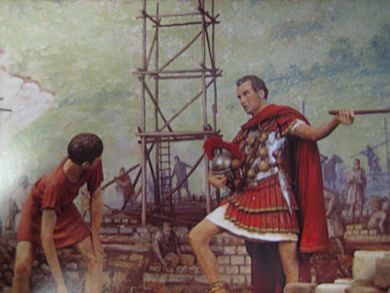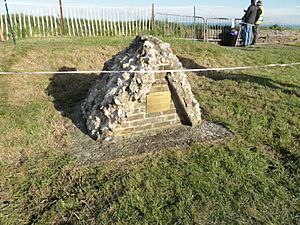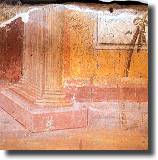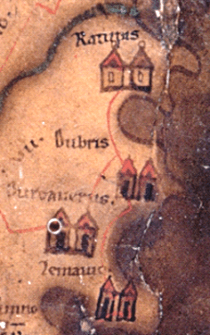Dubris facts for kids
Dubris was the Roman name for the port city we now call Dover, in Kent, England. It was also known as Portus Dubris and Dubrae.
Dover was a perfect spot for a port connecting to continental Europe. It was the closest point across the English Channel. The River Dour also flowed into the sea here. In Roman times, Dubris grew into a very important place. It was a busy port for trade and a key military base. Along with another Roman fort called Rutupiae, it was one of the starting points for the famous Roman road, Watling Street. Roman soldiers from the Classis Britannica (the Roman navy) and later from a Saxon Shore Fort protected it.
Contents
Julius Caesar's Visit
In 55 BC, the famous Roman general Julius Caesar tried to conquer Britain. His first plan was to land his ships at Dubris. His scouts had probably told him it was a good place to land.
However, when Caesar's fleet arrived, they saw many Britons gathered on the hills and cliffs above the shore. The cliffs were so close that people could throw spears down onto anyone trying to land. Because of this, Caesar decided not to land there. He waited for a few hours, then sailed about seven miles along the coast to a more open beach.
The Roman navy in British waters was called the Classis Britannica. Its main job was to protect the sea routes between Gaul (modern-day France) and Britain. It also helped the Roman army on land in Britannia (Roman Britain).
The main base for the Classis Britannica was in Gesoriacum (Boulogne) in Gaul. But it also had smaller bases in Britain. Two of these were at Rutupiae and Dubris.
Ancient Lighthouses
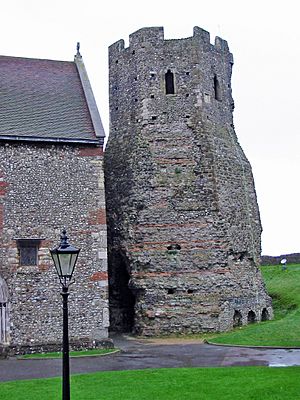
Soon after the Romans conquered Britain, they built two lighthouses at Dover. Each was called a Pharos. These lighthouses helped guide ships safely into the busy port.
Historians believe they were built sometime in the 1st century AD. They were placed on two high points: the Eastern Heights and the Western Heights. They were similar to a large lighthouse built in Boulogne.
The lighthouse on the Eastern Heights is still standing today! It's about 80 feet (24 meters) tall and is located in the grounds of Dover Castle. It has even been used as the bell tower for the nearby church, St Mary de Castro. This Roman lighthouse is a very important historical building.
Not much is left of the western lighthouse. Its remains are called the Bredenstone. It was covered up during building work in the 1700s but found again in the 1860s.
Dubris at its Busiest
At its busiest time, Dubris became a very important trading center. It took over from Rutupiae as the main Roman port for crossing the Channel.
Dubris and Rutupiae were the starting points for Watling Street. This famous Roman road led to Canterbury (which the Romans called Durovernum Cantiacorum) and eventually to London.
The Roman Painted House
In the 1970s, during the building of a new road (the A256/York Street bypass), workers found some amazing Roman remains. Archaeologists then dug up what is now known as the "Roman Painted House."
This building was a mansio, which was like a guesthouse for government officials and travelers. It was built around 200 AD. What makes it so special are the beautiful Roman wall paintings found inside. There are over 400 square feet (37 square meters) of painted plaster. This is the largest amount of Roman wall painting ever found north of the Alps! Because of this, some people call it "Britain's Buried Pompeii."
The paintings show a detailed architectural design. There are colorful panels framed by fluted columns. These columns look like they are standing on raised bases, creating a cool 3-D effect. Parts of 28 panels still exist. Each panel has a design related to Bacchus, the Roman God of wine.
Other interesting things found at the Painted House include some Roman gems. You can also see a medieval cut in the floor that lets you view the hypocaust system. This was the Roman underfloor heating system. A medieval skeleton, nicknamed "Fred," was also found nearby.
The Saxon Shore Fort
Around 270 AD, the Roman mansio (the Painted House) was taken down. This was done to make way for a new military base called a Saxon Shore fort.
Luckily, this demolition helped to preserve the mansio and its wall paintings. The lower parts of the walls were covered by the fort's rampart, protecting them from damage.
What You Can Still See Today
You can still see a small part of the Roman fort today. You can ask to see it at Dover Library and Discovery Centre. There's also a public house (a pub) near Market Square that is built on top of where the Roman Quay used to be. It's even named after it!
The best place to see Roman remains in Dover is at the Roman Painted House. Here, you can see parts of the mansio, the Saxon Shore Fort, and the Classis Britannica fort.
Discoveries in the 1980s
In the 1980s, the town council planned to build a car park on the site of the Roman Painted House. But the Kent Archaeological Rescue Unit (KARU), led by Brian Philp, started finding Roman remains there.
After some discussions with the council, the excavation was allowed to continue. KARU built a special cover-building over the site to protect the remains. The car park was built somewhere else. The museum was finished before the car park.
Since then, thousands of people have visited the Roman Painted House. This includes the Queen Mother, who signed a special guestbook. Brian Philp still helps manage the site and gives talks to students, tourists, and experts. Other important Roman items, like a special glass vessel, are also kept there.
The cover-building still stands over these ancient remains.
Images for kids
-
The Roman lighthouse at Dover Castle
See also
 In Spanish: Dubris para niños
In Spanish: Dubris para niños


